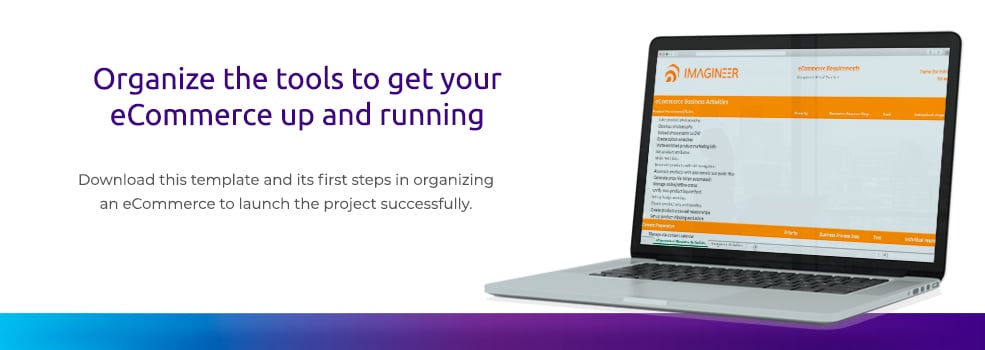Benefits of User Experience in Your Company's Ecommerce
Currently, many people prefer not to leave the comfort of their homes and do their shopping for clothing, shoes, accessories, food, technology, among...
The need to implement eCommerce solutions that allow your customers to place orders, inquiries, support, and online payments, is becoming increasingly apparent to many companies. Previously, there were questions about the implementation, use and user adoption of said eCommerce solutions, but most companies have already accepted that the future of their business is there and that they need a strategy.
In defining this strategy, it is important to understand what kind of processes you want to automate depending on your industry and business turn. Examples of processes you can automate include:
There are many use-cases beyond simply focusing on eCommerce processes. Digital transformation requires us to truly take our business processes through different digital solutions. These processes and the need for automation will vary depending on your industry, but no matter what this is, all employees, customers/citizens, and suppliers are crying out for automated processes in your company. Where to start? Our experience has charted a path of successful implementations by adopting the following model:
Step 1. Lifting Requirements
This may be the most basic step you could think of, but in our experience, it is the most underestimated step and where not enough budget is allocated. The secret at this point is the methodology used, many software manufacturers use a requirements survey based on functionalities that users want, but not based on the company's processes and procedures. If make this error, the delivery of the software and user discussions will be subject to phrases like: "This is the functionality you asked for", or "but that's not how we do it here at the company". Do you recognize these phrases? You’ve probably been through a similar situation. Unfortunately, the implementer is complying with what you have asked for, and will charge you for his work even if ultimately you will not obtain optimal results. This is because the software will not be used by its users since its processes have not been automated according to the needs of the business.
To avoid this error in the lifting of requirements, Imagineer recommends executing projects from the lifting of the processes and procedures that will be affected by the new system, in this case the commercial or operational processes. Yes, just like that! Process flowcharts guiding you step by step! This means you will be automating something that may never have been automated in your company, so you will need to plot new processes, procedures and business rules. Analysis such as As-Is/To-Be, SIPOC, gap analysis, time analysis, workloads, among others, may be used.
This will generate a detailed documentation of your needs and wants regarding implementation. This makes the prices and implementation proposals of the software companies better and permits you to be the one in control of the project, as it should be.
Step 2. Business Rules
An e-business project is more than the acquisition of a technology platform. A few years ago we understood that, in order for a Digital Transformation project to be successfully implemented, we needed improve the business rules of all the business areas involved, understanding that many processes will be affected from the start to the completion of a customer’s online management process. Some of the processes that are involved are:
For example, an online store sells the same or more than a physical store, but the benefit of selling online in terms of operating costs also involves making a strategy to meet delivery commitments. That strategy may include defining a procedure for receiving orders and delivery times, checking whether this process will be covered with its own logistics or by outsourcing the service, and defining business rules that must be associated with each step of the service. Some of the most common business rules to consider are: time rules, role rules and permissions, parameter rules, restriction rules, conditions rules, action rules, rules if – then and decision rules (otherwise). Whatever the decision you make about your platform is, be sure to define the business rules that should be scheduled in the online process.
Step 3. Third-party integrations
In this step, identify the necessary integrations. The most basic integrations that should include all e-business projects are:
Step 4. Select the right platform
Making the wrong platform decision has serious consequences. It is a significant investment of time and money that can produce real returns and competitive advantages for you and your customers if done correctly, but could be a real problem otherwise.
The cost of automating your business processes can vary as the type of project, the architecture, SKU’s, features of the tool among others. While each company is different, our experience tells us investment ranges may round between:
$10,000-$75,000 for small companies
$75,000-$250,000 for medium companies
$250,000<1,000,000 for large companies
So, ¿How to choose the correct platform having so many options?
Our recommendation is that you find references of tested global tools that already have the support and maturity to endure the requirements of your business. Two of the most popular benchmarks in the technology industry are Gartner and Forrester, however, we must keep in mind that investment in these tools is not always feasible for some regions such as Latin America. This means those regions should consider their reality before trying to jumpstart with any platform. Here are some of the leading technology platforms that can help your business in automating digital processes:
IBM
IBM has a lot of solutions, unfortunately, many are not implemented in Latin America mainly because there is no direct presence of the manufacturer. Today, companies like Wal-Mart and other multinationals use their solutions worldwide, which gives us a vision of what can be achieved with them. IBM as a software and hardware manufacturer can solve many of a company’s needs, but this is what makes it more expensive.
IBM use-case: Recommended for Large Companies with a large technology budget
Liferay
Liferay is a digital experiences platform, with a portfolio of solutions to automate any type of process through websites, portals, communities, social networks and other types of digital channels. This software has gained a lot of popularity for being a secure platform developed with high standards that allow the implementation of the solution with an OpenSource (Free) licensing model and another Enterprise.
This solution is robust enough and is used by companies such as Bank of America, Telefonica/Movistar, Costa Rican Ministry of Finance, Central Bank of Costa Rica and other large companies.
Liferay Use Case: Recommended for all types of companies. From low budgets with the Liferay OpenSource solution to large budgets for mission-critical applications with the Enterprise version.
Magento
Magento comes from of a platform as robust as eBay, which gives us an idea of the possibilities that this tool provides. It is very powerful and versatile, but perhaps the most attractive characteristic about it is its community licensing option that allows it to be implemented at no cost. This facilitates many companies’ decision making. Magento is a B2B and B2C trading platform used by companies such as Samsung, Nestlé, Nike, Coca Cola, among others.
Another benefit of Magento is its independence in terms of technological architecture. You can deploy Magento with any database, ERP or system, something that in some other manufacturers might be limited as their architectures work better with the software and hardware they sell.
Magento use-case: Recommended for any type of company, from those with small budgets with the Magento Community solution, to the ones with larger budgets for mission-critical applications with the Enterprise version.
Oracle
Without doubt one of the companies with greatest market growth with one of the best technology portfolios in the world. As any Oracle product, one of its greatest benefits is its database. It remains strongest one on the market and the one that will give your business the best returns, however, its cost is high and does not necessarily facilitate its implementation in all types of companies.
Oracle use-case: Recommended for large enterprises with a large technology budget.
Salesforce
Just as Oracle will associate all of its solutions with its Database and IBM with its hardware; Salesforce will do it with your CRM – arguably the best in the world. This isn't necessarily negative, but you should consider that a Salesforce deployment will focus heavily on the sales and service experience offered around the digital experience and marketing tools around it. After all, salesforce distinguishes itself from the rest.
Salesforce use-case: Recommended for medium-large companies with a large technology budget
The world's largest enterprise software company cannot be off this list. If your company is a food producer or manufactures, almost certainly, SAP is your ideal business platform.
SAP use-case: Recommended for large companies with a large technology budget.
You may want to take these recommendations into consideration when discussing the performance of your company’s current architecture with your technology department. A large company using SAP will hardly be able to implement a tool like Oracle since that will involve a radical change in your company's architecture. Niche solutions like Magento or Liferay can give you more flexibility in integration with other enterprise software without necessarily investing in large licensing.
Recommendations:
Understanding these solutions will not be beneficial if your organization isn't ready to address digital transformation projects since you won't have the support, resources or strategic alignment to get the job done. So, perform a realistic self-assessment! Here's a quick checklist for you:
If you answered "no" to any of these questions, it is best to advise yourself with one of our consultants and plan to prepare your company.


Currently, many people prefer not to leave the comfort of their homes and do their shopping for clothing, shoes, accessories, food, technology, among...

Do you know what the world's largest media and entertainment conglomerate, aka Disney, digital accommodation platform Airbnb, management systems...

In an environment where technology plays an increasingly significant role, digital transformation has established itself as an essential element for...